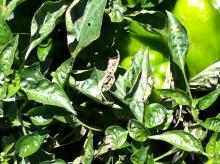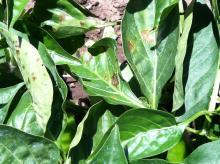Cause A bacterium, Xanthomonas vesicatoria (formerly X. campestris pv. vesicatoria), that is seedborne and frequently comes with transplants. It overwinters in infected debris and weeds such as nightshade. The bacterium is spread by splashing water and mechanical means such as pickers and/or picking equipment, particularly when plants are wet. Some strains are pepper specific and others can also infect tomato. Wet conditions or high relative humidity and warm temperatures (75°F to 86°F) favor disease development.
Symptoms Irregularly-shaped, water-soaked spots develop on leaves and turn brown or brown-black. The center may later fall out, leaving holes approximately 0.25 inch in diameter that give the plant a ragged look. Leaf spots may coalesce and result in large necrotic areas on leaves, ultimately resulting in severe defoliation. Stems and petioles develop dark streaks and patches. Fruit spots are often at the stem end where water collects and at first are water-soaked in appearance and later become brown, raised, and scabby.
Cultural control
- Plant pathogen-free seed.
- Use drip or furrow irrigation rather than overhead irrigation.
- Do not pick or cultivate plants when they are wet.
- Incorporate crop residues after harvest to hasten the breakdown of infected plant material and minimize the survival of any bacteria.
- Practice at least a two-year rotation between solanaceous crops, but three-year rotations are better for the management of other diseases.
Chemical control
- Treat seed with DryTec Calcium Hypochlorite Granular at 8 oz/gal water. Soak seed for 15 minutes with continuous agitation and then rinse seeds in potable water for 15 minutes. Dry the treated seeds to their normal storage moisture. Washington only (SLN WA-11,0008).
- Actigard 50WG (Group P1) at 0.33 to 0.75 oz/A on 7-day intervals is labeled for chili peppers. Do not apply within 14 days of harvest. 12-hr reentry.
- Copper (Group M1) applications during wet periods may help but avoid build-up of copper in the soil.
- Badge SC at 0.75 to 2.25 pints/A and 0.5 to 2 Tbsp/1,000 sq ft in greenhouses on 3- to 10-day intervals. Preharvest interval is 0 days. 24-hr reentry for greenhouse use; 48-hr reentry for all other applications.
- Bonide Liquid Copper is available for home gardens. H
- Champ Formula 2 at 1.33 to 2 pints/A. 48-hr reentry.
- Cueva at 0.5 to 2 gal/100 gal water on 7- to 10-day intervals. May be applied on the day of harvest. 4-hr reentry. O
- Cuprofix Ultra 40 Disperss at 1.25 to 3 lb/A on 5- to 10-day intervals. 48-hr reentry.
- Firewall at 200 ppm beginning when seedlings are in 2-leaf stage and continue on 4- to 5-day intervals until transplanted in the field. 12-hr reentry.
- Kocide 2000 at 1.5 to 2.25 lb/A or Kocide 3000 at 0.75 to 1.25 lb/A on 7- to 10-day intervals. 48-hr reentry.
- Liqui-Cop at 1.5 to 3 teaspoons/gal water. H
- Nu-Cop 50 WP at 1.5 lb/A on 3- to 14-day intervals. 48-hr reentry. O
- Previsto at 1 to 2 quarts/A on 5- to 10-day intervals. 48-hr reentry. O
- Dexter Max (Group M3 + 11) at 1.7 to 2.25 lb/A on 7- to 10-day intervals. Preharvest interval is 7 days. 24-hr reentry.
- Regalia (Group P5) at 1 to 4 quarts/A plus another fungicide on 7- to 10-day intervals. Does not benefit from the addition of an adjuvant. Preharvest interval is 0 days. 4-hr reentry. O
Biological Control Efficacy in the Pacific Northwest is unknown.
- Double Nickel LC at 1 to 6 quarts/A on 3- to 10-day intervals. Can be applied the day of harvest. 4-hr reentry. O
- LifeGard WG at 1 to 4.5 oz/100 gal on 7- to 14-day intervals for activating plant resistance. Refer to label for appropriate rate per application volume. Preharvest interval is 0 days. 4-hr reentry. O
- Serenade Opti at 14 to 20 oz/A on 2- to 7-day intervals. Applications can be made up to and the day of harvest. 4-hr reentry. O
- Sonata at 2 to 4 quarts/A on 7- to 14-day intervals. Can be applied up to and on the day of harvest. 4-hr reentry. O
- Stargus at 2 to 4 quarts/A plus a nonionic surfactant on 7- to 10-day intervals. Preharvest interval is 0 days. 4-hr reentry. O


